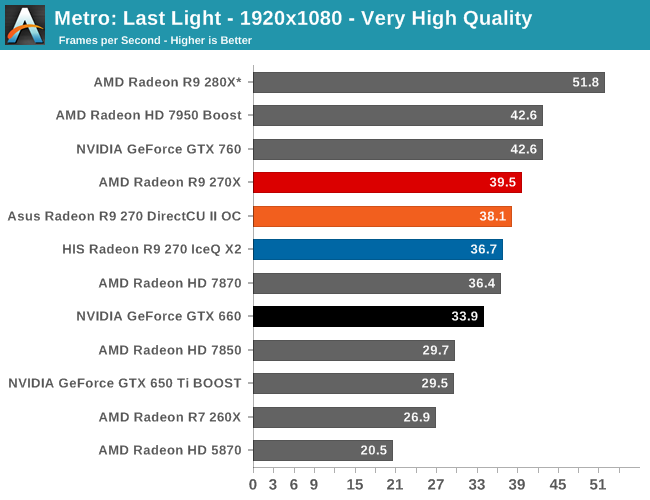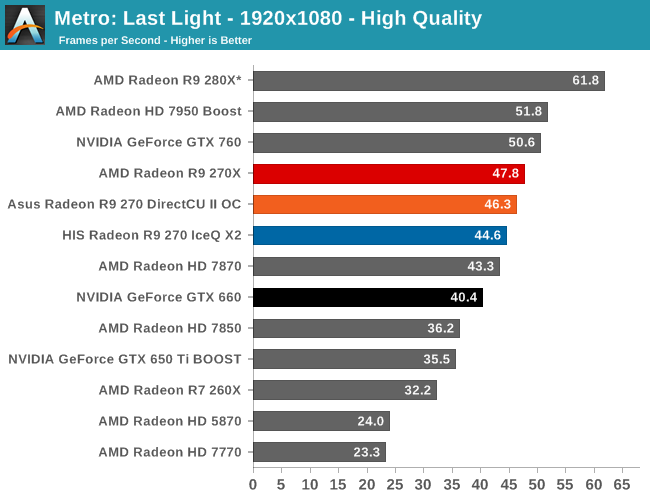The AMD Radeon R9 270X & R9 270 Review: Feat. Asus & HIS
by Ryan Smith on November 13, 2013 12:01 AM ESTMetro: Last Light
As always, kicking off our look at performance is 4A Games’ latest entry in their Metro series of subterranean shooters, Metro: Last Light. The original Metro: 2033 was a graphically punishing game for its time and Metro: Last Light is in its own right too. On the other hand it scales well with resolution and quality settings, so it’s still playable on lower end hardware.


AMD likes to pitch the 270 series as their primary 1080p cards, and although they generally do a perfectly fine job at it, Metro is a reminder that there are scenarios where they will come up short, particularly if trying to do 1080p at the highest quality settings. For these cards if we want framerates better than the 30s, we have to look at moving down a quality level.
At 1080p high quality, we can get our 270 cards up to the mid-40fps range. 270X of course leads the pack, but the 270 cards are very close behind owing to the fact that the only difference between the cards is the GPU clockspeed.
For the 270X in particular we’re looking at performance just a few frames per second behind the more expensive GTX 760, for a deficit of 6%. Otherwise the only cards close to it are of course the 270, and the outgoing 7870.
As for our 270 cards, they are second only to the 270X in anything near their price. The Asus card with its factory overclock is as to be expected faster, essentially splitting the difference between the stock clocked HIS 270 and the 270X. Furthermore in this test both cards are faster than the 7870 – a Pitcairn card with higher clockspeeds – showing the potency of the memory clockspeed increase. Finally, both cards are 10%+ faster than the GTX 660, making this an easy win for AMD.










59 Comments
View All Comments
Waveblade - Wednesday, November 13, 2013 - link
It's like different people work on different products!Roland00Address - Wednesday, November 13, 2013 - link
A commandment of any cell phone reviews, thou shall not rush battery life tests.Tetracycloide - Wednesday, November 13, 2013 - link
Be thou particularly careful testing battery life when thine available anecdotes vary wildly. Be thou definitive.slayerxj - Wednesday, November 13, 2013 - link
I may not read the article very carefully, and I keep wondering that why 280X has a star behind it.Gigaplex - Wednesday, November 13, 2013 - link
I'm getting a little tired of this TDP nonsense. Two cards with the same TDP from the same product family of the same manufacturer that clearly consume different amounts of power - the TDP numbers are now meaningless. And don't get me started on Intels SDP.yannigr - Wednesday, November 13, 2013 - link
If both are under 150W, then where is the problem? Maybe R9 270 consumes close to 130W-140W and not 150W, giving the necessary room to AMD's partners to oc the chip without passing the 150W limit.dylan522p - Wednesday, November 13, 2013 - link
OCed 270 is 270xslapdashbr - Monday, November 18, 2013 - link
Under 150W means it only needs one 6-pin power connector (like the 7850 or 660 which it replaces/competes with) and in general is much more power-efficient. The 270 (non-x) is aimed more at builders with power limits or old systems that can't support a dual-6-pin GPU, or perhaps computational tasks where performance per watt is more important than performance per card. The 270x is full-powered but less efficient and is better suited for gamers and tweakers. I wouldn't get a 270 to save $20 unless the lower power limit was important, in which case it's actually a good buy, as it should still edge out a gtx 660 while staying under 150W total power.dylan522p - Wednesday, November 13, 2013 - link
SDP at least makes sense.maximumGPU - Wednesday, November 13, 2013 - link
quick comment on the DCUII coolers from asus. I too have been very impressed with them. my goal was silent yet powerful computing, and the DCUII cooler on my GTX670 plays that part admirably.